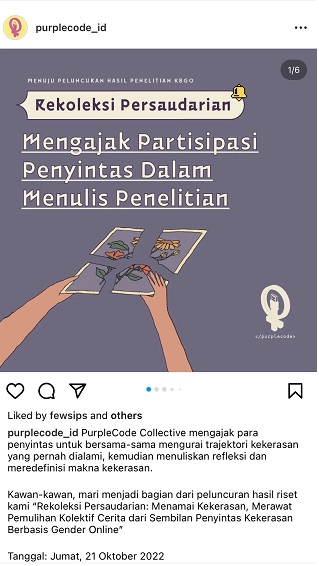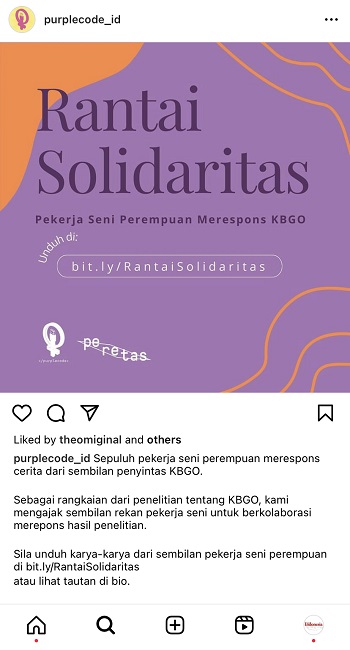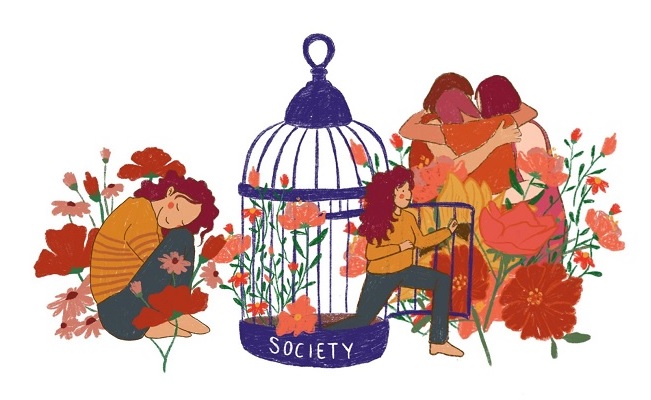A reflection from research with survivors of Online Gender-based Violence (Kekerasan Berbasis Gender Online/KBGO)
Eni Puji Utami
Versi Bh Indonesia
Being involved in research designed to go beyond the 'usual' research concepts was new to me. As an individual who first knew ethnography from its general construction and reference in multiple academic spaces, this research process led me to a new definition of ethnography. I am ‘haunted’ by the definitions of participation, contribution, and intervention in every research project I enter into. For once, here was research concerned with questions of how to realise justice. Also, I couldn’t help thinking: who owns the rights of the knowledge and experience that are shared as knowledge production in the research findings? Does it belong entirely to the researcher? Then, who will be referred as the researcher, when all the participants in it were offering up ideas?
A journey spanning a year and a half with KBGO survivors had me personally witness for the first time the breakdown of the concept of object. While conducting research, we were not to represent a particular group or unilaterally attach values; not even ‘showing’ instead of providing space. We believed that the involvement of all parties in this research was an attempt to seize space, getting rid of the extremes of give-and-take. Before, during, and post-research stages, including when a number of female art workers responded to its findings, we always strived to avoid exploitation and exoticisation.
This article may also stray from the rules of academic writing let alone a scientific one. I am merely reflecting on a simple research process. In the process, we exchanged meanings with each other, recharged energy which led to happiness, recovered from trauma together, and made way for an equal sisterhood.
Joint design: Ethnography as a feminist methodology
In mid-early 2021, PurpleCode Collective launched a study on Online Gender-based Violence (KBGO). With Instagram as our only social media platform, we worked for nine days, calling survivors to participate. Of the 22 survivors who volunteered, we invited nine of them to work on this research together. The selection was based on the limitation and scope of our research, as well as our ability and energy to walk together, for we did not want to simply gather data and information from them and then leave.

In the process, we referred to the nine survivors as research partners. We made a joint design. The framework and research plan that we’d developed earlier was only used to jumpstart other ideas, based on the needs and experiences of our research partners. As partners, the nine survivors took part in the entire process; designing, compiling and distributing research results, as well as in other activities related to their interests outside of the research, such as recovery efforts. All we wanted throughout this research was for there to be no hierarchical boundaries with our research partners. It was our belief and intention that all researchers were equal and would be treated the same way. We believed that the knowledge and experience of our research partners played a consequential role in our efforts to name violence and nurture a collective recovery. We exchanged the baggage of knowledge carried over from various research teams. This sometimes led to a new complexity, and we saw it as a form of wealth of the research process.
The nine survivors dedicated their time, energy, and themselves. All plans were mutually agreed upon. We sent them an empty book as a medium for their storytelling and as a meeting point, which some would later call a recovery room in the form of a diary. Through the book we collected stories from our research collaborators. We formulated a number of questions, but we did not ask them outright. As far as it allowed, we gathered the answers to these questions from our partners’ diaries innately or naturally. In fact, many more emerged from the diaries, beyond what we had expected.
We met twice a week, facilitated by their handwritten diaries. The stories they shared in the diaries started with an outline of the feelings, conditions, and situations weathered by each partner. We always asked these questions at the start of the week before addressing other issues, although those issues sometimes simply presented themselves in the process of breaking down the stories. Writing and problem-solving did not take place in one sitting. We asked our research partners to submit their notes as photographs over the weekend. We read them and used them to prompt other questions for the following week, based not only on research references but also on the conditions of the partners that required a follow-up.
In setting up boundaries, we had a discussion, and two out of ten survivors needed further help. At first glance, it might not sound like part of our research, however, we felt that we had a responsibility to walk with them, especially considering the needs that arose at the time were closely related to their mental and physical conditions, which we called the continuum of violence. This ‘continuum’ was not initially an aspect of our research; in fact, we only discovered the term ‘continuum’ after the journaling process wrapped up. The principle was that beyond the work of analysing and writing research results lied the human relationship with our research partners.
The research was be completed over a fairly short period of time, but as the ethnography work progressed this plan shifted. Even if it had to run at a slower pace, we realised that we must accept certain limitations and realities, especially in relation to the conditions of our research partners. Originally, the data and information collection were to conclude in eight weeks. In fact, it took longer than that. During the process, some research partners needed to take a break, and by the final third leg of the journaling process some had had enough. We reminded each other that this research was our journey together and extra energy would be given to support those in need. This process was time consuming and called for a balance, and it was not the responsibility of only one person to provide all the energy; rather, we relied on our interdependence to make sure our steps did not falter. Even when we made a pit stop, we would take to walk again, running not required.
We faced many uncertainties in our joint design, but we positioned them as a natural hurdle to overcome. From the beginning we agreed to adhere to a feminist methodology, which includes the following eight principles: realise that there is an imbalance of power; expand research questions; listen to women's voices and experiences; incorporate approaches that recognise diversity and intersectionality; use multidisciplinary research methods; reflect; build social relations in the research process; use research results that have been presented.
To make sure we did not get ahead of ourselves we also needed partners to read the findings and analyses of the research. The process was not without criticism. We received feedback to stay in the research lane with a feminist perspective, side, and methodology. As the journaling process progressed, we met several research partners in person and spoke with others on the telephone. Our aim was not only to confirm our findings, but we also saw it as a need to meet as partners, as sisters.

This research took place during the COVID-19 pandemic in which physical encounters were highly limited, and technology-enabled violence (one of which was KBGO) was nearly unbridled. Technology, which was not neutral from the start, had become one of the triggers for gender-based violence, and had also become a tool that connected us with our research partners. Ethnography as a feminist methodology, in reality, grew dynamically.
Keep going, today and in the days to come
The process that originally involved ten research partners concluded with nine stories. Every step we took needed to be approved by our partners, starting from the structuring of research results, their distribution, and all other co-occurring activities. We respect the time our research partners needed to review all of it before giving their consent, no matter how long it took. We waited for their consent and did not take further steps without receiving it from each of them.
We returned the manuscript to our research partners and discussed their wishes. Almost all of them wanted their stories to be shared with as many women as possible so that KBGO would be more visible and for there to be preventive measures; if there were victims who read it, they wished that the results of this research could be a source of strength for them, offering comfort without hugging. We deliberately did not alter much beyond cleaning up the spelling and grammatical errors. We intended for this manuscript to be read as if the reader was listening to the voices of survivors.
Following the release of the research findings, a group of ten female art workers responded to the survivors’ stories contained in it. Before acting on their request to be involved, we asked our research partners for their permission. Then after the female art workers finished designing, producing, and were preparing to show their work, we sent it to our research partners for further examination. We hoped that the responses to their stories, would further propel their hopes for distributing energy and forging connections. The partners agreed.
The whole process strayed quite far from the original plan because we did not expect to collaborate with anyone other than our research partners. Watching all of this work unfold, I personally feel touched, sorrowful and also hopeful. The female arts workers fortified this chain of solidarity by designing a joint exhibition. During the preparation, more than once did they reminded us that reading our partners’ stories brought forward the desire to collaborate, empower survivors out there, and combat KBGO together. The exhibition was held online, and later also offline in Yogyakarta and Ambon. To this day, we keep communicating with our research partners. We believe that if we continue to work together this chain of solidarity will never break.
Eni Puji Utami is part of the PurpleCode Collective. She works on handling online gender-based violence cases with the KBGO TaskForce. Their research papers can be downloaded at bit.ly/RekoleksiPersaudarian and zine works by the female artists responding to this research accessed at bit.ly/RantaiSolidaritas. Instagram: purplecodecollective_id












